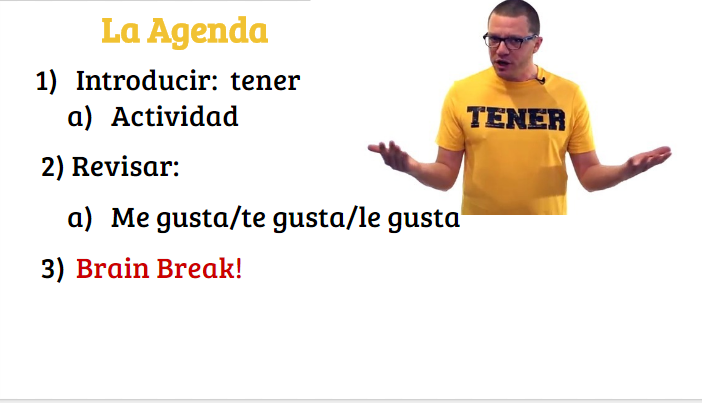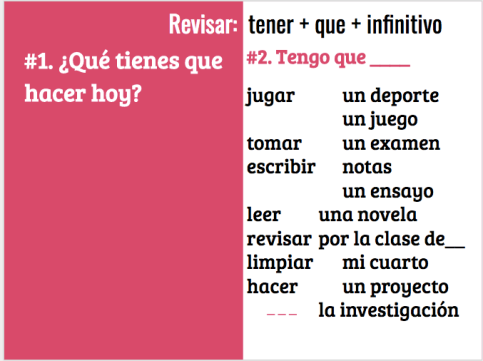“It is the question that drives us.” —The Matrix
La Evolución de la Pregunta
It begins with a question at the beginning of the year: “¿Qué tienes?
I teach the verb structure “tener” the second week of school, so this question pops up around the third week as warm-up, third slide in the Google line up of the day.
First slide is always meme in the target language while I take roll…

…afterwards, students 1) talk to their elbow partners and then 2) discuss as a class.
The second slide is always the agenda.

Up to this point we’ve done a lot of activities circling around family: ¿Cuántos hermanos tienes? ¿Tienes una mascota? ¿Qué tienes en tu mochila? ¿Qué tienes por tu almuerzo?
After a lot of practice, most of my students can answer this question confidently. They fall back on “Tengo cinco hermanas” or “Tengo un gato“.
However, there are always a few stars who can do more:
“Tengo tres personas en mi familia; no tengo hermanos, pero me gusta mi gato.”
“Tengo una galaxia en mi mochila, una puerta a otro mundo.” (I seriously love this kid.)
Having introduced this verb structure as part of our warm-up, we cover it in various forms as a conversational starter for up to two weeks. Then I switch to another type of warm up, another verb structure, another angle on creating comprehensible input.
But the original question is not forgotten.
It adapts over time as the students learn more and more.
In January, we moved up from September’s “What’s in my backpack?” to this:

And so our conversational warm-ups morphed into guided practice:

And then in March, we were ready to have some fun. (This vocabulary is some review from our second novel read in class, Piratas del caribe y el mapa secreto.)

Student responses included:
“No tengo que escapar de piratas por la clase de ejercicio.”
“No tengo que preparar los cañones por la clase de historia.”
“No tengo que atacar piratas en la cafetería durante el almuerzo porque hay pizza por todos.”
This is the evolution of just one verb and one type of warm-up that I use. While I focus on the Super Seven repeatedly throughout our first year together, we also highlight other verbs and practice with other types of warm-ups.
And this is just how we begin class!

And, that’s a wrap!
So is the vocabulary dropped into earlier lessons as it is in this one? And does the basic verb form drive the “to” version of “que.” Literally, Maria has (tiene) to (que) study (basic v) or is it the basic verb following the que? I’m not being a pest. I ask because the first time I learned Spanish I learned too much Spanish. “Yo no tengo uno pedal volumen para teclado electronica marca de Korg.” When, in conversation, “no tengo un pedal para Korg” was enough. Or “no pedal para este” with a finger.
LikeLiked by 1 person
So, a little about my teaching philosophy: I use R. Scott Benedict’s Immediate Immersion curriculum, but it isn’t a book. It’s a guide for what to do, week by week. There is no textbook. There is no homework. There are no drills, vocab lists or test. And it’s working beautifully. We have vocab we work on specifically but there’s a lot of words that just come up naturally, so I put them on the board, add them to the lesson, and keep going. The verb “tener” followed by “que” creates the obligation. Otherwise, “tener” just means “to have”, but not in the “have to” sense. Until you add “que”. The infinitive that follows is what has to be done. I teach it as, “When your mom tells you to clean your room, you realize you HAVE to, right? It’s not a request; you HAVE to go do that! Tengo que limpiar mi cuarto.”
LikeLiked by 1 person